#Ann Arbor 2002
Text



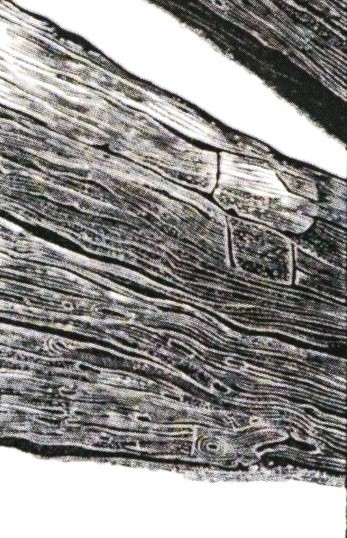



Wood Engraving Wednesday
TONY DREHFAL
Wisconsin wood engraver Tony Drehfal delights in intricate, tightly-focused, textured surfaces as demonstrated in this 17.5 x 12.7 cm (6.9 x 5 in.) print entitled Dovetail, selected by my Wisconsin colleagues Tracy Honn and Jim Moran for inclusion in the Fourth Triennial Exhibition 2020-2022 of the American American wood engravers society, the Wood Engravers’ Network (WEN). This image is from the catalog for that travelling show.
Drehfal learned wood engraving from Ann Arbor wood engraver and WEN founder Jim Horton in 2002, and after a 35-year career as a college photographer, Drehfal retired in 2015 to focus exclusively on wood engraving. He has quickly become a leader in the wood engraving community, and is a member of both WEN and its venerable British counterpart, the Society of Wood Engravers. Of his process, Drehfal writes:
Landscape and the minute details of the natural world serve as the primary inspiration of my wood engravings. Photography, drawing and engraving interweave in my creative process. I take photos often during hikes . . . near my home . . . in northern Wisconsin. Over time, recurring visual themes accumulate; birch trees, decaying stumps, knots and bark textures, and reflections in woodland ephemeral pools. I then draw and expand a theme in my sketchbook, using photos as reference. There is a point when photo references are put away and the process of drawing and wood engraving take on their own natural cadence towards a resulting print.



View other posts with engravings from the WEN Fourth Triennial Exhibition.
View more engravings by members of the Wood Engraver’s Network.
View more posts with wood engravings!
– MAX, Head, Special Collections and juror for the WEN Fifth Triennial Exhibition.
#Wood Engraving Wednesday#wood engravings#wood engravers#Tony Drehfal#Dovetail#Wood Engravers' Network#WEN#WEN Fourth Triennial Exhibition#exhibitions#exhibition catalogs
53 notes
·
View notes
Text
celeste st. james



aka. celly, lest, lessie, cel, baby
born on december 11th 2002 in san diego
has a fraternal twin sister, maeve st. james, who majors in nursing and plays volleyball at boston college
she’s 3 minutes older than maeve
their dad left before they were born
shares her love for fashion with her mom and sister, her mom managing a boutique in san diego and her sister having a fashion-tik tok account
hockey player at umich
usually plays center or right wing
originally wanted to go to a different school, not even having umich on her list, but she kinda cruised through high school not worrying about grades so she had to resort to hockey to get her into a college
has absolutely no intention to play professionally after college even though everyone says she could and should
majoring in fashion & design
dreams of owning an atelier in paris or milan one day
has had the outline of starting her own label saint james since she was 9 years old and got her first sowing machine
is the team and her friends’ personal tailor but loves it so much
loves the ocean and the beach
is a really good surfer
is the life of every party she attends
beer pong, strip poker, chugging, drinking games, you name it she does it
has half the football team chasing after her but never goes home with anyone, or keeps it under wraps enough for not even her friends to know
plays with number 18 because it’s her moms lucky number
will get a dog once she graduated college
helps out at animal shelters in ann arbor when she has the time
often takes dogs out for her runs with her if they need to be walked
works at a cafe during the off season to be able to buy fabrics
firmly believes she’ll never need a man, especially not one that’ll leave when things get hard
there’s rumors around campus that she’s a lesbian because she never entertains any guy
is straight though
really is just scared of being vulnerable with someone and giving them all of her just for them to leave her
#celeste st. james#ethan edwards#ethan edwards x reader#ethan edwards x oc#ethan edwards imagine#goldie's fuck it i love you au
22 notes
·
View notes
Text

elle wiggins
born august 11, 2002
only child and a very bad relationship with her parents
majoring in marketing
played volleyball through high school

cassidy dawson
born november 29, 2002
from ann arbor
oldest of four siblings
younger brothers include evan (15, 2008), shane (11, 2012), and connor (5, 2018)
parents are divorced but mom remarried and had connor
majoring in communications and media with a minor in creative writing
gymnast but not competitively anymore. she still works out and works with kids at her local gym though!

isabelle fantilli
born november 13, 2003
goes by “izzy” to most people, only nick is allowed to call her “belle”

hallie rae morgan
born january 11, 2005
rural midwestern girlie
freshman at umich
studying sport management

summer hannigan
born may 21, 2005
stay at home mom
does side gigs styling hair for weddings, school dances, photo shoots, whatever she is available for and gets scheduled for

lexi james
born june 10, 2003
majoring in graphic design

grace (pope) drysdale
born march 12, 2003
stay at home mom

sadie hughes
born may 14, 2001
jack hughes twin sister
went to umich for film, television, and media with a minor in broadcasting

skye jennings
born april 11, 2002
devils photographer
two brothers, one older and one eight years younger. her mom left after the birth of the younger one and skye later finds out she remarried but they aren’t in contact.
#raegan talks about blurbs#mark x elle#tyler x cassidy#moldy x fantilli#luca x hallie#baby bedsy#baby drysdale#baby zegras#connor x lexi
32 notes
·
View notes
Text
Art in the Stations: West Riverfront



Once known as Joe Louis Arena Station, West Riverfront is making way for a new neighborhood feel. Whimsical, glittery colors in "Voyage" by Gerome Kamrowski embodies both mythology and astrology. The tiles were made in Spillemberg, Italy by Crovatto Mosaics- the same company that created "Calvacade of Cars" in Huntington Place Station!
Kamrowski has been creating beautiful glass mosaics for many years, as shown below in "2002, Cottage Studio, Ann Arbor."

Hop off the Detroit People Mover and head to the riverwalk to check out the beautiful pedestrian path as well as the new Water Square development.
Although there is a lot of work to be done to make it a walkable neighborhood, the 25-story Residences at Water Square is under construction at the former Joe Louise Arena site. Currently pre-leasing for February 2024, the project is coming together nicely!





#artinthestations#detroitpeoplemover#westriverfront#detroitriver#detroitriverfront#joelouisarena#joelouis#dpm
4 notes
·
View notes
Photo

ann arbor michigan [2002]
8 notes
·
View notes
Text
Adobe Photoshop
A. Pengertian
Adobe Photoshop adalah software editor grafis raster yang dikembangkan oleh Adobe Inc. Software ini menjadi standar untuk mengedit grafis gambar. Photoshop menawarkan beberapa fitur efek dan tool untuk memanipulasi foto untuk meningkatkan hasil yang berkualitas. Software berbasis bitmap ini dipakai para desainer grafis untuk mengolah gambar dengan mengubah pewarnaan, menggabungkan, memberi efek, hingga membuat masking dari objek yang diedit. Adobe Photoshop dapat menyusun gambar dengan bantuan fitur layer (lapisan) di dalamnya.
B. Mode warna yang dapat digunakan Photoshop
Beberapa model pewarnaan yang bisa didapatkan yaitu ;
RGB Color Model
Lab Color Model
CMYK Color Model
Grayscale
Bitmap
Duotone
C. Jenis Format yang umum digunakan file asli Photoshop
.PSD (Photoshop Document), format yang menyimpan gambar dengan isi bentuk layer, yang meliputi teks, opacity, blend mode, mask, channel warna, channel alpha, clipping paths, pengaturan dua tonal (setting duotone).
.PSB sebuah format terbaru dari PSD yang versinya digunakan untuk file berukuran besar (lebih dari 2 GB).
.PDD adalah versi yang diperuntukkan untuk mendukung fitur perangkat lunak PhotoshopDeluxe.
D. Sejarah singkat Adobe Photoshop
Adobe Photoshop dikembangkan pada tahun 1987 oleh dua bersaudara yaitu Thomas Knoll dan John Knoll. Pada tahun 1988 mereka menjual lisensinya ke perusahaan Adobe Systems Incorporated. Saat itu Thomas seorang mahasiswa Ph.D., merancang program dengan nama Display, sebuah program penampil gambar skala abu-abu pada tampilan monokrom. Kemudian berkolaborasi dengan saudaranya seorang karyawan Industrial Light & Magic untuk mengerjakan program ini. Thomas mengganti nama program dengan nama ImagePro namun karena kendala ia mengubah nama programnya menjadi Photoshop.
Pada waktu itu, Thomas melanjutkan demonstrasi program ke Silicon Valley dan menemui insinyur Apple, yang juga seorang direktur seni di Adobe bernama Russel Brown. Berkat pertunjukannya lisensi Photoshop berhasil dibeli Adobe untuk didistribusikan pada September 1988. Thomas tetap bekerja sebagai programmer di Ann Arbor, sementara John memilih bekerja pada plug-in di California. Versi pertama Photoshop 1.0 dirilis pada 19 Februari 1990 untuk Macintosh.
Program ini terus ditingkatkan dalam segi fitur warna setiap rilisnya, hingga Photoshop menjadi standar industri dalam pengeditan warna digital. Photoshop untuk Macintosh dijual seharga $385 saat itu. Seorang kepala arsitek Adobe bernama Seetharaman Narayanan memindahkan Photoshop ke Microsoft Windows pada tahun 1993. Jangkauan program ini akhirnya terpasarkan lebih luas karena Port Windows Microsoft yang global. Karena pesatnya jangkauan Photoshop, Adobe membeli hak paten program dari Thomas dan John Knoll seharga $34,5 juta pada setiap royalti jual setiap salinannya.
Adobe Photoshop diawali dengan versi 1.0 pada Februari 1990 hingga 7.0 pada 2002. Kemudian pada 2003 diubahlah versi rilisnya menjadi Photoshop CS 8.0 hingga CS6 pada Mei 2012 dengan membawa branding Creative Suite. Setelah versi CS berakhir, Adobe meluncurkan update lisensi terbaru bersama Creative Cloud pada 9 Januari 2017. Versi CC ini dimulai pada 18 Juni 2013 Photoshop CC (14,0), kemudian versi lanjutannya CC 2014 (15.0), CC 2015 (versi 16 dan 17), CC 2017 (versi 18), CC 2018 (versi 19), CC 2019 (versi 20), Photoshop 2020 (versi 21), 21.1, dan 21.2 pada Juni 2020.
E. Fungsi dan manfaat Adobe Photoshop
Adobe Photoshop secara umum difungsikan sebagai alat untuk pengeditan gambar dan membuat manipulasi efek pada gambar. Namun ada banyak fungsi detail dari program ini, berikut di antaranya:
Editing foto dengan penambahan efek manipulasi.
Mengatur tonal warna atau mengubah warna.
Menghilangkan atau menghapus objek atau bagian pada gambar.
Mengatur ukuran gambar dengan mengubah ukuran kecil atau lebih besar.
Membuat kombinasi dua gambar atau lebih menjadi satu kesatuan atau gambar baru.
Mengatur resolusi foto.
Pengeditan kualitas foto dengan cara mempertajam, menyamarkan (blur), memperhalus, dan meningkatkan tingkat kecerahan gambar.
Menggabungkan objek gambar, bentuk, dan foto maupun memotong gambar.
dan masih banyak lagi beragam fungsi dan manfaat Photoshop lainnya.
Membuat sketsa gambar
Membuat Ikon Logo
Membuat efek gambar dan tulisan
Untuk prosesing konten web, seperti gambar konten web.
Dari semua fungsi di atas, Adobe Photoshop memungkinkan masih bisa digunakan dalam beragam fungsi editing lainnya, tergantung eksplorasi penggunanya. Apalagi Adobe Systems terus membuat perkembangan fitur dan fasilitas terbaru dari program Photoshop.
F. Tools dan bagian Adobe Photoshop
Tool atau bagian utama yang ada pada Adobe Photoshop cukup mudah dikenali, karena ini merupakan komponen penting yang akan pengguna gunakan saat membuka program ini.
Layer – Adalah lapisan dari kanvas yang berisi satu objek atau gambar yang sedang pengguna desain. Tool ini merupakan bagian penting yang digunakan untuk mengatur tata letak dan susunan lapisan pada kanvas atau lembar kerja Photoshop. Layer memiliki ciri seperti lapisan kaca transparan yang bertumpuk pada panel bagian, biasanya layer tersusun dari lapisan terbawah yang disebut layer background, selanjutnya ada lapisan bentuk atau objek, lapisan warna, lapisan teks, dan ragam objek lainnya.
Tool – Adalah alat yang berguna untuk mendesain dan mengedit gambar atau objek.
Menu – Merupakan menu bar tempat menyimpan keseluruhan tool pada Photoshop. Menu dapat dilihat pada deretan atas Photoshop, di sana terdapat ragam Menu inti yaitu : File, Layer, Edit, Image, Window, Select, 3D, Filter, Analysis, View, dan Help.
Toolbox – Bagian kotak yang berisi kumpulan alat perintah, terletak di bagian kiri lembar kerja kanvas. Beberapa ragam tool ini di antaranya, Move Tool, Marque Tool, Lasso Tool, Quick Selection Tool dan Magic Wand Tool, Crop dan Slice Tool, Brush Tool, Eraser Tool, Gradient Tool dan masih banyak lagi jenisnya.
G. Fitur utama Adobe Photoshop
Fitur Photoshop merupakan hasil penggunaan dari banyaknya tool yang ada di dalam Photoshop. Melalui laman Adobe Photoshop, banyak sekali penggunaan fitur yang bisa dikerjakan pada software ini. Adanya keberadaan tools ini akan memudahkan para editor grafis untuk berkarya dan menunjang kegiatannya.
1. Layers (Layer lapisan) – Merupakan lapisan dari suatu desain yang tersusun, pengerjaan desain gambar yang diedit tersusun dari background, efek bayangan, lapisan warna, elemen gambar, font, dan lain-lain. Selain menyusun layer per lapisan Anda juga bisa melakukan grouping maupun menggabungkan layer tersebut agar tertata rapi.
2. Paint Bucket atau Fill – Fitur ini akan berguna untuk menuangkan cat atau warna berdasarkan kesamaan warna. Fill sendiri adalah warna latar yang sedang dipakai. Dengan Paint Bucket maka Anda bisa mengklik bagian mana saja untuk dilakukan pewarnaan.
3. Eyedropper – Fitur ini merupakan alat khusus untuk menentukan warna apa yang kita colek dari bagian yang dipilih. Anda akan memilih warna tertentu dalam gambar atau dokumen Photoshop dengan menggunakan alat ini.
4. Berintegrasi dengan Adobe Font – Pada pembaruan Adobe Photoshop, Adobe juga mempermudah pengguna dalam memilih font, dengan penambahan fitur integrasi dengan Adobe Fonts. Sehingga fitur ini memungkinkan pengguna agar tidak susah mencari font saat mendesain.
5. Select and Mask – Sebuah fitur untuk menyeleksi bagian pada objek dan membuat background yang terseleksi terhapus atau tertutup dengan masker. Dulu fitur ini bernama Refine Edge. Dengan fitur Select and Mask akan mendapatkan hasil seleksi yang lebih detail.
6. Match Font – Sebuah fitur hebat yang berguna untuk mendeteksi kemiripan font dengan gambar yang Anda masukkan. Dengan fitur ini pengguna tidak repot-repot untuk browsing ke situs web pendeteksi font, karena dengan menggunakan Match Font, font yang mirip atau sesuai dapat dipilih.
7. Content-Aware Fill atau Content Aware Move – Sebuah fitur yang berguna untuk mengisi bagian gambar yang dipilih secara halus. Content Aware Fill akan menyeleksi area objek yang dipilih dan dapat disesuaikan pengaturannya untuk mencapai hasil yang maksimal. Misal, sebuah gambar pemandangan yang di tengah-tengah ada pohon, namun kita ingin menghilangkan pohon dan menyamakan bagian itu dengan rumput. Nah dengan fitur ini, Photoshop akan mengisi bagian yang hilang tadi secara sempurna dengan lingkungan rumput di sekitarnya.
Saat ini fitur ini sudah diperbarui menjadi Content Aware Move, tepatnya pada edisi terbaru Photoshop CS6, bukan hanya bisa menghilangkan sebuah objek, tetapi Anda bisa memindahkan objek foto dari satu tempat ke tempat lainnya.
8. Photoshop Brushes (kuas Photoshop) – Fitur yang menyediakan alat untuk membuat brush atau sapuan pada media gambar. Kuas ini juga digunakan untuk menghapus dan manipulasi retouching foto untuk mendapat hasil yang sempurna.
9. Peningkatan Lens Blur – Sebuah fitur yang dapat meningkatkan hasil ketajaman juga mengaburkan media gambar dari latar depan, belakang dan tengah. Selain itu dengan fitur ini Anda bisa memberikan efek bokeh yang bagus melalui highlight specular, agar gambar terlihat realistis.
10. Photo Effects – Photoshop memberikan fitur photo effects yang cukup lengkap untuk di explore. Beberapa di antaranya menggunakan efek filter seperti tema drama dengan subtracting color, gaya retro untuk filter artistic, membuat painterly effects, retouch gambar, dan masih banyak pengaturan efek yang bisa dicoba pada Photoshop.
1 note
·
View note
Text
Saturday 18th March 2023, Ann Arbor, 4.18am.
#144,192 — She had been accompanying her elder child to the school bus stop on a winter’s morning in 2002. He can no longer love his wife and his children, and the only person he can relate to is the other survivor of the crash.
0 notes
Text
Lost in random review embargo

Technical report, Department of Industrial Engineering, Bilkent Universityįeeny GJ, Sherbrooke CC (1966) The inventory policy under compound Poisson demand. Oper Res 56(4):916–936įadıloglu MM, Berk E, Gurbuz MC (2005) An EOQ model with multiple vendors and binomial yield. Int J Prod Econ 78:239–253įedergruen A, Yang N (2008) Selecting a portfolio of suppliers under demand and supply risks. Nav Res Logist 53:101–114Įrdem AS, Ozekici S (2002) Inventory models with random yield in a random environment. Dissertation, Department of Industrial Engineering, Bogazici UniversityĮrdem AS, Fadıloglu MM, Ozekici S (2006) An EOQ model with multiple. Manag Sci 35:149–163Įrdem A (1999) Single-period inventory models with two vendors and random yield. Oper Res 11:922–927Įrlenkotter D, Sethi S, Okada N (1989) Planning for surprise: water resources development under demand and supply uncertainty. Int J Prod Res 25(12):1795–1803Įisen M, Tainiter M (1963) Stochastic variations in queueing processes. Manuf Ser Oper Manag 9(1):9–32Įhrhardt R, Taube L (1987) An inventory model with random replenishment quantities. Prob Eng Inf Sci 1:97–115ĭada M, Petruzzi N, Schwarz L (2007) A newsvendor’s procurement problem when suppliers are unreliable. Çinlar E, Çinlar S (1987) Reliability of complex devices in random environments. Nav Res Logist 54(5):544–555Ĭiarallo FW, Akella R, Morton TE (1994) A periodic review production planning model with uncertain capacity and uncertain demand-optimality of extended myopic policies. J Oper Res Soc 42:713–720Ĭhopra S, Reinhardt G, Mohan U (2007) The importance of decoupling recurrent and disruption risks in a supply chain. Stoch Models 2:245–263Ĭheng TCE (1991) EPQ with process capability and quality assurance considerations. Interfaces 19(1):48–67Ĭhauveau D, Martin CF, Van Rooij ACM, Ruymgaart FH (1996) Discrete signed mixture of exponentials. Oper Res 35(2):274–281Ĭhao HP, Chapel SW, Clark EJ, Morris PA, Sandling MJ, Grimes RC (1989) EPRI reduces fuel inventory costs in the electric utility industry. Stoch Models 3:115–148Ĭhao HP (1987) Inventory policy in the presence of market disruptions. Nav Res Logist 41:129–132īotta RF, Harris CM, Marchal W (1987) Characterization of generalized hyperexponential distribution functions. Oper Res 47(4):632–642īerk E, Arreola-Risa A (1994) Note on “Future supply uncertainty in EOQ models”. Department of Industrial and Operations Engineering, University of Michigan, Ann Arbor (working paper)īassok Y, Anupindi R, Akella R (1999) Single-period multiproduct inventory models with substitution. Oper Res 42:111–118īassok Y, Yano CA (1992) Optimal finite and infinite horizon policies for a single stage production system with variable yields. J Stoch Anal Appl 11:11–27īerg M, Posner MJ, Zhao H (1994) Production-inventory systems with unreliable machines. Appl Stoch Models Bus Ind 27: doi: 10.1002/asmb.879īar-Lev SK, Parlar M, Perry D (1993) Impulse control of a Brownian inventory system with supplier uncertainty. Nav Res Logist 45:687–703īalcıog̃lu B, Gürler Ü (2011) On the use of phase-type distributions for inventory management with supply disruptions. Manag Sci 39(8):944–963Īrreola-Risa A, DeCroix GA (1998) Inventory management under random supply disruption and partial backorders. Anupindi R, Akella R (1993) Diversification under supply uncertainty.

0 notes
Text
Lynn Conway (1938-)
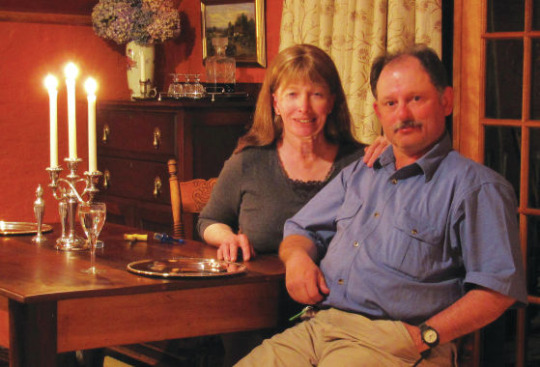
Lynn Conway is a transgender pioneer whose longtime passion has been sports, particularly adventure sports. She's overcome two similar life obstacles (transitioning and a fear of heights) en route to her current state: a 75-year-old Michigan resident—reflective and respected, passionate and accomplished, innovative and intelligent.
"In a strange way, while rock-climbing years ago I was learning exactly what I needed to transition, learning how to overcome fear," Conway said. "Although scared of heights, I worked up to some modest climbing in Yosemite Valley—and passionately enjoyed it."
Conway, who lives west of Ann Arbor, has been married to Charlie since 2002; they have been together since 1988. The two were in Washington D.C., this past June for the President's White House Reception in celebration of LGBT Pride Month. Joy, hope and optimism carried throughout the event, filled with other activists, advocates and allies.
Conway has been out and a trans-rights advocate for 15 years, although her involvement with the LGBT community began decades earlier.
"When I went away to college in 1955, I was finally free to begin exploring—but it was very difficult," Conway said. "I thought I was gay [early on because] society was telling me I was. So I sort of randomly tried to find my way into the gay world, but that didn't work."
Enjoying sailing while in college, Conway was also drawn to rock climbing, finding joy in conquering her fear of heights a step at a time.
After earning her degrees at Columbia University in the early 1960s, Conway went west into a computer research career and into climbing in Yosemite and the Sierra Nevada. By then she knew what she had to do. She completed her transition in 1968 while living in San Francisco.
"Most of my transition mentors were trans-girls who were either sex workers or entertainers at places like Finnochio's," she said, reflecting on an era long past. "No way could I have been out back then and found a regular job. I didn't have the talent to be an entertainer, so I'd have ended up in sex work."
All along, sports were Conway's crutch, her supporting shoulder. The adventure sports were dangerous and difficult, but transitioning was as well. However, the sports were also exciting. "It's the learning that's fun, the exploring that's fun," she said.
Conway became a widely known computer pioneer while living in stealth after her transition. She also took up whitewater slalom racing and went on to motocross racing, sports that, no doubt, brought her back to summer camp, at age 10, in Maine.
"[Camp] was a transformative experience in my life because all at once I learned about things like making fires, hiking, camping, fishing, swimming, horseback riding, rifle shooting and more," Conway said. "It's what set off my tomboyish adventure-seeking."
Source: https://windycitytimes.com/ARTICLE.php?AID=44404
Conway's website: https://ai.eecs.umich.edu/people/conway/conway.html
#women in history#trans women in history#20th century history#1900s#us women in history#21st century history#us history#living people
0 notes
Text
In a paradox, cleaner air is now adding to global warming | Science

It’s one of the paradoxes of global warming. Burning coal or gasoline releases the greenhouse gases that drive climate change. But it also lofts pollution particles that reflect sunlight and cool the planet, offsetting a fraction of the warming. Now, however, as pollution-control technologies spread, both the noxious clouds and their silver lining are starting to dissipate.
Using an array of satellite observations, researchers have found that the climatic influence of global air pollution has dropped by up to 30% from 2000 levels. Although this is welcome news for public health—airborne fine particles, or aerosols, are believed to kill several million people per year—it is bad news for global warming. The cleaner air has effectively boosted the total warming from carbon dioxide emitted over the same time by anywhere from 15% to 50%, estimates Johannes Quaas, a climate scientist at Leipzig University and lead author of the study. And as air pollution continues to be curbed, he says, “There is a lot more of this to come.”
“I believe their conclusions are correct,” says James Hansen, a retired NASA climate scientist who first called attention to the “Faustian bargain” of fossil fuel pollution in 1990. He says it’s impressive scientific detective work because no satellite could directly measure global aerosols over this whole period. “It’s like deducing the properties of unobserved dark matter by looking at its gravitational effects.” Hansen expects a flurry of follow-up work, as researchers seek to quantify the boost to warming.
Some aerosols, such as black carbon, or soot, absorb heat. But reflective sulfate and nitrate particles have a cooling effect. For many years, they formed from polluting gases escaping from car tailpipes, ship flues, and power plant smokestacks. Technologies to scrub or eliminate this pollution have spread slowly from North America and Europe to the developing world. Only in 2010 did air pollution in China begin to decline, for example, and international restrictions on sulfur-heavy ship fuel have come just in the past few years.
The new study, submitted as a preprint to Atmospheric Chemistry and Physics in April and expected for publication in the next few months, grew directly out of last year’s U.N. climate assessment. It included studies showing aerosol declines in North America and Europe but no clear global trends. Quaas and his co-authors thought two NASA satellites, Terra and Aqua, operating since 1999 and 2002, might be able to help.
The satellites tally Earth’s incoming and outgoing radiation, which has enabled several research groups, including Quaas and his colleagues, to track the increase in infrared heat trapped by greenhouse gases. But one instrument on Aqua and Terra has also shown a decline in reflected light. Models suggested a decrease in aerosols is partly responsible, says Venkatachalam Ramaswamy, director of the National Oceanic and Atmospheric Administration’s Geophysical Fluid Dynamics Laboratory. “It’s very hard to find alternate reasons for this,” he says.
Quaas and his co-authors have now taken things a step further with two instruments on Terra and Aqua that record the haziness of the sky—and therefore its aerosol load. From 2000 to 2019, haze over North America, Europe, and East Asia clearly declined, although it continued to thicken over coal-dependent India.
Aerosols don’t just reflect light on their own; they can also alter clouds. By serving as nuclei on which water vapor condenses, pollution particles reduce cloud droplet size and increase their number, making clouds more reflective. Reducing pollution should undo the effect—and using the same instruments, Quaas and his team found a clear decrease in cloud droplet concentrations in the same regions where aerosols declined.
The evidence in the paper is clear, says Joyce Penner, an atmospheric scientist at the University of Michigan, Ann Arbor. “It’s remarkable that we’re seeing this already,” she says. “This is contributing a lot to the climate changes we’re seeing in the current era.”
Just how much this declining reflectivity has boosted recent warming is hard to quantify, says Stuart Jenkins, a doctoral student at the University of Oxford who is also studying the aerosol decline. In forthcoming work, Jenkins will show there’s just too much natural variability in the past 20 years to pick out the effect of clearer skies.
Whatever the exact contribution, it is sure to grow as air quality continues to improve around the world. The answer isn’t to keep polluting, says Jan Cermak, a remote-sensing scientist at the Karlsruhe Institute of Technology. “Air pollution kills people. We need clean air. There is no question about that.” Instead, efforts to reduce greenhouse gases need to be redoubled, he says.
But with Earth having warmed by some 1.2°C since preindustrial times, Hansen thinks there’s little hope of cutting emissions fast enough to meet the 1.5°C target he and other scientists have called for. And so the solution, he says, could come back to aerosols, this time ones spread deliberately through solar geoengineering—the controversial idea of lofting sulfate particles into the stratosphere and creating a global, reflective haze. “It will be necessary to take temporary corrective measures,” he says, “almost surely including temporary purposeful use of aerosols to avoid catastrophic implications.”
New post published on: https://livescience.tech/2022/07/21/in-a-paradox-cleaner-air-is-now-adding-to-global-warming-science/
0 notes
Quote
She carried herself like she was one body, a whole, not a collection of disjointed limbs, and for this reason I believed her to be very intelligent and I was in awe of her and a little bit in love with her.
Miranda Popkey, Topics of Conversation
#miranda popkey#topics of conversation#literature#lit#words#quotes#bookbly#bibliophile#she#herself#intelligent#Susan Sontag#woman#love#stranger#Ann Arbor 2002#Intelligence#act
6 notes
·
View notes
Note
i know your focus is latin, but do you have any favorite articles/scholarship on the iliad you'd recommend? you seem to know a lot about it, and pairing those with the text worked great for me with the odyssey, but for iliad specific texts i don't know where to start 😳 thanks either way!
hellooo i am going to copy and paste the iliad section of the bibliography from the module i took on epic poetry. i havent read Everything on here but it was intended to be Introductory so it should help! bolded is stuff that i remember being Extra Good
AUSTIN, N. (1994), Helen of Troy and her shameless phantom, Ithaca.
CAIRNS, D., ed. (2002), Oxford Readings in Homer’s Iliad, Oxford.
COLLINS, C., Studies in Characterisation in the Iliad, Frankfurt.
CROTTY, K. (1994), The Poetics of Supplication, Ithaca.
EDWARDS, M. (1987), Homer: Poet of the Iliad, Baltimore.
LYNN-GEORGE, M. (1987), Epos: Word, Narrative and the Iliad, Basingstoke.
MACLEOD, C. (1980), Iliad 24: A Commentary, Cambridge. [Introduction]
MUELLNER, L. (1996), The Wrath of Achilles, Ithaca.
NAGY, G. (1975),.The Best of the Achaeans: Concepts of the Hero in Archaic Greek Poetry, Baltimore.
POSTLETHWAITE, N. (2000) Homer’s Iliad. A Commentary on the Translation of Richmond Lattimore, Exeter.
RABEL, R. (1990), ‘Apollo as a model for Achilles in the Iliad’, AJP 111, 429-40.
REDFIELD, J. (1994), Nature and Culture in the Iliad, 2nd edn, Durham NC.
SLATKIN, L. (1991), The Power of Thetis: Allusion and Interpretation in the Iliad, Berkeley.
SCHEIN, S. (1984), The Mortal Hero: An Introduction to Homer’s Iliad, Berkeley.
SCULLY, S. (1990), Homer and the Sacred City, Ithaca.
SEGAL, C. (1970), The Theme of Mutilation of the Corpse in the Iliad, Oxford.
SILK, M. (1987), Homer: the Iliad, Cambridge.
TAPLIN, O. (1992), Homeric Soundings, Oxford.
VIVANTE, P. (1991), The Iliad: Action as Poetry, Boston.
WILLCOCK, M. (1976) A Companion to the Iliad Based on the Translation by Richmond Lattimore, Chicago.
WILSON, D. (2002), Ransom, Revenge and Heroic Identity in the Iliad, Cambridge.
ZANKER, G. (1994), The Heart of Achilles, Ann Arbor.
also not on this list but useful / personal faves are
the blackwell companion to ancient epic - j.m. foley (ed.) and particularly nagy's chapter on epic heroism (also this book can be found online. eye emoji)
in fact it's always a good idea to check various brill/cambridge/blackwell companions to [topic] bcs they Exist to give you a cool and scholarly introduction!
the language of achilles - adam parry. hhhhhhhhhhhh. i die
#im a latinist but im also a person who correctly perceives that epic poetry is one of the sexiest genres out there. sorry callimachus :/#alsoooooo clutuals i am once again asking for bibliography recs for an anon blease#book list#iliad#beeps
455 notes
·
View notes
Text
The ‘Does this make sense?’ check - Introduction, Part 1
Fanfiction does many of the things book historians are interested in, yet it is understudied from a book historical point of view. Fanfiction studies includes copyright and publishing history, reader-author relationships, communal reading practices, and material production. Writing and sharing fanfiction provides insight into contemporary, pop cultural reading practices and creative responses to multimedia texts. Fanfiction offers many entry points for book historians to consider textual production, the future of textual media and the digital book, and reader response. Fanfiction writers and readers alike engage with texts in myriad ways that unsettle many assumptions that book historians take for granted, including Robert Darnton’s communication circuit, the reexamination of which anchors this dissertation.
This dissertation relies on Francesca Coppa’s definition of fanfiction, which articulates six characteristics that illuminate the relationships between fic writers, fic readers, and distributing platforms. These six characteristics of fic are critical to the fic communication circuit: they place fic adjacent to Darnton’s standard model, they challenge ownership and for-profit motives of textual production, and they illustrate a more immediate reader response and creative interpretation than is typical in analogue media:
Fic is ‘created outside of the literary marketplace’, that is, without the intent for profit and without the institutional recognition of traditional publishing.
Fic ‘rewriters and transforms other stories’, and
Fic ‘rewrites and transforms other stories currently owned by others’. Coppa elaborates: ‘it is only in such a system—where storytelling has been industrialized to the point that our shared culture is owned by others—that a category like “fanfiction” makes sense’ [1]. That is to say, in a system where stories can be bought or sold, the transformative, for-pleasure work of fanfiction is defined in contradistinction to for-profit story production and distribution; in a system without purchase and ownership of stories, the work of fanfiction would be called ‘folklore’.
Fic is ‘written within and to the standards of a particular fannish community’: fic writers signal to their readers their understanding of a fandom and place within it using intertextuality and other methods.
Fic is speculative in that it is (often) more interested in ‘character rather than about the world’. Fic provides space to elaborate on internal motivations, examine secondary characters in the source text, and explore how circumstances change a character.
Fic is ‘made for free, but not “for nothing”’, meaning that while fic is rarely made and shared for profit, participants receive satisfaction in the form of kudos, feedback, art, and friendship [2].
These features place fanfiction (and the fanfiction communication circuit) outside of traditional publishing, maintained by different criteria. As a textual practice often associated with women’s crafts, fanfiction shares characteristics with coterie manuscript practices: non-profit driven, for pleasure, and privately produced. Catherine Coker argues that this gendering reinforces the ‘hierarchies of value between print and digital that emphasize traditional patriarchal and public practices of reading and writing over private coterie practices’ [3]. She notes that fanfiction, which is dominated by women and gender-nonconforming people, was born from and is a continuation of these ‘private coterie practices’ that were not valued precisely because they were ‘women’s work’ and ‘not-for-profit’ [4]. In examining the function of writer, reader, and fannish response in the succeeding chapters, I argue that fanfiction attains value and success through community and gift-giving, rather than the norms of profit and mainstream circulation.
Darnton presents a sufficient and adaptable model for describing the relationship between author, printer, publisher, distributor, and reader in his communication circuit [5]. Padmini Ray Murray and Claire Squires note that in a reconstructed circuit for the digital publishing age, ‘the traditional value chain, …is being disrupted and disintermediated at every stage’ [6]. This disruption in the traditional circuit holds true for the production, dissemination, and consumption of fanfiction. Because fanfiction mostly exists in tandem to the source text upon which it is based and, by extension, the literary marketplace, I model the fanfiction communication circuit in tandem with, rather than superimposed upon, Darnton’s communication circuit. Murray and Squires argue that in digital publishing, the author and publisher roles and the publisher and distributor roles are conflated. In fanfiction (hereafter referred to as fic), production and distribution are similarly conflated, as the publishing (rather, posting) and distributing platforms are one and the same for many interfaces, and the fic writer has sole control over posting their work. These conflations merit a ‘re-examination’ of Darnton’s model, in which I outline a fandom communications circuit in tandem with Darnton’s circuit to parallel, rather the superimpose upon, the circulation of fic text with source text [7].
This dissertation examines transformative works: works that change, even ever so slightly, the metatext unto a given purpose. In 2002, a representative at LucasFilm said, ‘“We've been very clear all along on where we draw the line. We love our fans, we want them to have fun. But if in fact somebody is using our characters to create a story unto itself, that's not in the spirit of what we think fandom is about. Fandom is about celebrating the story the way it is”’ [8]. This statement marks the difference between affirmational and adaptive-transformational fandom (and the notion that creatively responding to a work is somehow not celebrating it) [9]. Transformational fandom is less interested in taking the work as it is, as LucasFilm attempts to dictate, and more interested in intervening in a source text for new or continued storytelling. Transformative fanfiction turns commonly-accepted models of Anglo-American book production on its head: book history often operates under a precept to follow the money. In the case of fanfiction, there is typically no financial compensation, and we must instead follow the fan community. The return is in the gift-economy, comprising kudos, likes, favorites, follows, art, feedback, comments, and further works inspired by one’s own.
Citations
Francesca Coppa, The Fanfiction Reader: Folk Tales for the Digital Age (Ann Arbor: University of Michigan Press, 2017), p.7.
Coppa, The Fanfiction Reader, pp.2-14.
Catherine Coker, ‘The margins of print? Fan fiction as book history’, Transformative Works and Cultures, 25 (2017)<https://journal.transformativeworks.org/index.php/twc/article/view/1053>1.2.
Coker, ‘The margins of print?...’, 2.2.
Robert Darnton, ‘What is the history of books?’, Daedalus, 111, pp.65-83.
Padmini Ray Murray and Claire Squires, ‘The digital publishing communications circuit’, Book 2.0, 3 (2013), p.3.
Murray and Squires, ‘The digital publishing communications circuit’, p.4.
Amy Harmon, ‘“Star Wars” Fan Films Come Tumbling Back to Earth’, The New York Times, 28 April, 2002; Maciej Ceglowski, ‘Fan is A Tool-Using Animal’, 6 Sep 2013, <https://idlewords.com/talks/fan_is_a_tool_using_animal.htm>.
obsession_inc, ‘Affirmational fandom vs. Transformational fandom’, dreamwidth, 2009 <https://obsession-inc.dreamwidth.org/82589.html>.
#does this make sense check#dissertation#research#introduction#fanfiction communication circuit#fanfiction definition#Francesca Coppa#Catherine Coker#Robert Darnton#Padmini Ray Murray#Claire Squires#Amy Harmon#obsession_inc#transformational vs affirmational
60 notes
·
View notes
Text
Week 2
From Origins to the Future: The Hero and the Epic Quest.
This week and the next we shall engage in one of the traditional approaches to comparative practice, following various re-appearances of a myth / hero / genre through successive literary periods and in different countries. The example we shall use is the figure of Odysseus / Ulysses in epic writing and film from Homer to the turn of the 21st century. We shall consider how this figure has changed, and focus on specific episodes of Homer’s original epic poem.
Homer, The Odyssey (read in particular Book 1 and the episode of the Cyclops (in Book 9);
Dante, Inferno (read canto 26, Ulysses);
James Joyce, Ulysses (read the ‘Cyclops’ episode (the 12th, pp. 280-330 in Johnson))
Stanley Kubrick, 2001: A Space Odyssey (1968) (Film: Please watch this in advance of the seminar)
Some secondary reading on Homer’s Odyssey & the figure of Odysseus/Ulysses
Boitani, Piero, The Shadow of Ulysses: Figures of a Myth, tr. Anita West (Oxford: Clarendon Press, 1994). [Has an excellent chapter on Dante's Ulysses]
Doherty, Lillian E., "The Snares of the Odyssey: A Feminist Narratological Reading", in Texts, Ideas, and the Classics: Scholarship, Theory, and Classical Literature, ed. by S. J. Harrison (Oxford: Oxford University Press, 2001), pp. 117-133.
Foley, John M. (ed.), A Companion to Ancient Epic (Oxford: Blackwell, 2005)
Fowler, Robert (ed.), The Cambridge Companion to Homer (Cambridge: Cambridge UP, 2004).
Graziosi, Barbara, end Emily Greenwood (eds.), Homer in the Twentieth-Century: Between World Literature and the Western Canon (Oxford: Oxford University Press, 2007).
Jong, Irene de, A Narratological Commentary on the Odyssey (Cambridge: Cambridge University Press 2001)
Hall, Edith, The Return of Ulysses: A Cultural History of Homer’s Odyssey (London and New York: I.B. Tauris, 2008).
Lane Fox, Robin, Travelling Heroes: Greeks and their Myths in the Epic Age of Homer (London: Allen Lane, 2008)
Manguel, Alberto, Homer’s The Iliad and The Odyssey A Biography (London: Atlantic Books, 2007).
Murnaghan, Sheila, Disguise and Recognition in the Odyssey (Princeton: Princeton University Press, 1987).
Stanford, W. B. The Ulysses Theme: A Study in the Adaptability of a Traditional Hero (Ann Arbor: University of Michigan Press, 1963).
Some secondary reading on Kubrick
Bizony, Piers, 2001: Filming the Future (London: Aurum, 1994)
Chion, Michel, Kubrick's Cinema Odyssey. Trans. Claudia Gorbman (London: BFI, 2001)
Ciment, Michel, Kubrick. Trans. Gilbert Adair (New York: Holt, Rinehart, and Winston, 1983)
Cocks, Geoffrey, James Diedrick, and Glenn Perusek (eds.), Depth of Field: Stanley Kubrick, Film and the Uses of History (Madison, WI: University of Wisconsin Press, 2006)
Falsetto, Mario, Stanley Kubrick: A Narrative and Stylistic Analysis (Westport, Conn; London: Praeger, 1994)
Falsetto, Mario (ed.), Perspectives on Stanley Kubrick (New York: G.K. Hall; London: Prentice Hall, 1996)
Herr, Michael, Kubrick (New York: Grove Press, 2000)
Kolker, Robert (ed.), Stanley Kubrick's 2001: A Space Odyssey: New Essays (Oxford: Oxford University Press, 2006)
Nelson, Thomas Allen, Kubrick: Inside a Film Artist's Maze (Bloomington: Indiana University Press, 1982)
Naremore, James, On Kubrick (London: British Film Institute, 2007)
Rasmussen, Randy, Stanley Kubrick: Seven Films Analyzed (London: McFarland, 2001)
Wheat, Leonard F., Kubrick's 2001: A Triple Allegory (Lanham, MD, and London: Scarecrow Press, 2000)
Some secondary reading on the epic
Bates, Catherine (ed.), The Cambridge Companion to the Epic (Cambridge: Cambridge University Press, 2010)
Beissinger, Margaret, Jane Tylus, and Susanne Wofford (eds.) Epic Traditions in the Contemporary World: The Poetics of Community (Berkeley: University of California Press, 1999)
Clarke, M. J., B. G. F. Currie, and R. O. A. M. Lyne (eds.), Epic Interactions: Perspectives on Homer, Virgil, and the Epic Tradition (Oxford: Oxford University Press, 2006)
Danow, David K., Transformation as the Principle of Literary Creation from the Homeric Epic to the Joycean Novel (Lewiston, NY: Edwin Mellen Press, 2004)
Elley, Derek, The Epic Film: Myth and History (London: Routledge & Kegan Paul, 1984)
Foley, John Miles (ed.), A Companion to Ancient Epic (Oxford: Wiley-Blackwell, 2009)
Hardie, Philip, The Epic Successors of Virgil: A Study in the Dynamics of a Tradition (Cambridge: Cambridge University Press, 1993)
Hainsworth, J. B., The Idea of Epic (Berkeley: University of California Press, 1991)
Hurst, Isobel, Victorian Women Writers and the Classics: The Feminine of Homer (Oxford and New York: Oxford University Press, 2006)
King, Katherine Callen, Ancient Epic (Chichester: John Wiley & Sons, 2009)
Konstan, David and Kurt A. Raaflaub, eds., Epic and History (Chichester: Wiley-Blackwell, 2010)
Merchant, Paul: The Epic (London: Methuen, 1971)
Miller, Dean A., The Epic Hero (Baltimore and London: Johns Hopkins University Press, 2000)
Johns-Putta, Adeline, The History of the Epic (Basingstoke and New York: Palgrave Macmillan, 2006)
Newman, John Kevin, The Classical Epic Tradition (Madison: University of Wisconsin Press, 1986)
Quint, David, Epic and Empire: Politics and Generic Form from Virgil to Milton (Princeton, N.J: Princeton University Press, 1993).
Roisman, Hanna M., and Joseph Roisman (eds.), Essays on Homeric Epic (Waterville, ME: Colby College, 2002)
Toohey, Peter, Reading Epic: An Introduction to the Ancient Narratives (London : Routledge, 1992)
Tucker, Herbert F., Epic: Britain's Heroic Muse 1790-1910 (Oxford and New York: Oxford University Press, 2008)
Winnifrith, Tom, Penelope Murray and K.W. Gransden, eds., Aspects of the Epic (London: Macmillan, 1983)
Some secondary reading on Ulysses
Guidebooks: (These classic ‘guidebooks’ can supplement the annotations in your edition of Ulysses.)
Don Gifford, Ulysses Annotated (Berkeley: University of California Press, 1988) Weldon Thornton, Allusions in Ulysses: An Annotated List (Chapel Hill: University of North Carolina Press, 1968) Harry Blamires, The New Bloomsday Book (London: Routledge, 1996)
Some suggested criticism on Ulysses
(This is a small selection of Joycean criticism, from useful collections of essays (Attridge, Latham, Hart and Hayman), to critics who read language and narrative very closely (Kenner, Senn), to works on the Homeric in Ulysses (Flack, Kenner, Seidel), to a few examples of studies which read Joyce through theoretical, historical, comparative, and postcolonial approaches.)
Derek Attridge, ed., The Cambridge Companion to James Joyce (Cambridge: Cambridge University Press, 1990) — ed., James Joyce’s ‘Ulysses’: A Casebook (Oxford: Oxford University Press, 2004) Scarlett Baron, ‘Strandentwining Cable’: Joyce, Flaubert, and Intertextuality (Oxford: Oxford University Press, 2012) Frank Budgen, James Joyce and The Making of ‘Ulysses’ (Bloomington: Indiana University Press, 1961) Vincent J. Cheng, Joyce, Race and Empire (Cambridge: Cambridge University Press, 1995) Leah Culligan Flack, Modernism and Homer: The Odysseys of H.D., James Joyce, Osip Mandelstam, and Ezra Pound (Cambridge: Cambridge University Press, 2015) Clive Hart and David Hayman, eds., James Joyce’s ‘Ulysses’: Critical Essays (Berkeley: University of California Press, 1974) Hugh Kenner, Joyce’s Voices (Berkeley, Los Angeles, and London: University of California Press, 1978) — ‘Ulysses’ (London: George Allen and Unwin, 1980) Sean Latham, ed., The Cambridge Companion to ‘Ulysses’ (New York: Cambridge University Press, 2014) Karen Lawrence, The Odyssey of Style in ‘Ulysses’ (Princeton: Princeton University Press, 1981) Andrew J. Mitchell and Sam Slote, eds., Derrida and Joyce: Texts and Contexts, ed. (Albany: State University of New York Press, 2013) Katherine Mullin, James Joyce, Sexuality and Social Purity (Cambridge: Cambridge University Press, 2003) Michael Seidel, Epic Geography: James Joyce’s ‘Ulysses’ (Princeton and Guilford: Princeton University Press, 1976) Fritz Senn, Inductive Scrutinies: Focus on Joyce, ed. Christine O’Neill (Dublin: Lilliput, 1995) — Joyce’s Dislocutions: Essays on Reading as Translation, ed. John Paul Riquelme (Baltimore and London: Johns Hopkins University Press, 1984)
Online searchable concordance of Ulysses (e.g. if you can’t remember where the renowned Irish hero ‘Napoleon Bonaparte’ is mentioned, type it into a ‘string search’ and untick ‘whole word’) http://joyceconcordance.andreamoro.net/
Ulysses Synopsis
Ulysses: A Synopsis “Telemachia” 1 - “Telemachus” (Oxford World’s Classics, ed. J. Johnson, pp. 3-23 / Penguin, ed. D. Kiberd, pp. 1-28)- The chapter opens with Buck Mulligan celebrating a parodic mass in which Stephen Dedalus becomes an acolyte in spite of himself. Stephen is a melancholy artist obsessed with guilt since the death of his mother; his taciturn nature is contrasted with Mulligan’s clownish joviality. The Englishman Haines, their guest in the Martello Tower, combines seriousness with an enthusiasm for Gaelic culture; the three characters illustrate three possible positions in relation to Ireland, which is symbolised by the old peasant woman who brings in the milk: the dispossessed Son (Stephen), the treacherous usurper (Mulligan); the representant of English imperialism (Haines) who - through his dream of the panther, traditionally a symbol of Christ - is also associated by Stephen with the imperialism of the Roman Catholic Church. Stephen chooses errancy and exile: he gives over his key and will not come back. 2- “Nestor” (OWC 24-36 / Penguin 28-45)- Stephen teaches history and English Literature to a class of well-off schoolchildren who are disconcerted by his caustic humour and riddles. He confronts Mr Deasy (Nestor in Homer’s Odyssey) on Irish history and economics. The old headmaster cherishes his inaccurate reminiscences and promotes thrift, whereas Stephen squanders away the little money he has. Stephen views history as a nightmare. Despite the antagonism, Stephen agrees to help Mr Deasy is his fight against the foot and mouth disease which affects Irish cattle by helping him to publish a letter in the press. 3 - “Proteus” (37-50/45-64)- Stephen’s philosophical and aesthetic meditations lead him to question the reality of the outside world. Through a complex philosophical argument which hesitates between Aristotle and Berkeley, he redefines for himself the nature of visual and auditory perception. His literary recollections blend with the painful evocation of his past, especially the unsuccessful exile in Paris from which a telegram announcing his mother’s death recalled him. The sterility of Stephen’s “creations” in this chapter (which include urinating and depositing a snot on a ledge of rock [cf. Bloom’s own excremental “creation” in “Calypso”]) is pitted against the remarkable metamorphic poetic prose of the narrative and of Stephen’s stream of consciousness. Odyssey 4 - “Calypso” (53-67/64-85)- Leopold Bloom, who will increasingly become the major protagonist, is introduced in his home at 7 Eccles Street and is first seen preparing breakfast for himself and his wife Molly, who is still in bed. He goes out in search of a pork kidney at a Jewish butcher’s, where he picks up a leaflet advertising plantations in Palestine (inaugurating the theme of the lost, promised land, and of the “recall”). He brings Molly her mail, which includes a letter from Boylan, her future lover later in the day, announcing his visit. He explains to Molly the meaning of metempsychosis; the chapter ends with his defecation in the outhouse, mingled with his remarks on cheap literature. 5 - “The Lotus Eaters”(68-83/85-107) - Bloom has left his house for what will become the epic wanderings of an untypical literary hero, on an ordinary Dublin day - 16 June 1904. He first goes to fetch the reply, sent post restante, from his unknown penfriend Martha Clifford, to whom he sends amorous letters signed “Henry Flower”. He runs into several acquaintances on the way, unwittingly “throws away” a tip for the horse races (the source of a later misunderstanding), and eventually goes to the public baths. Throughout the chapter, drugs of all kinds (perfumes, tobacco, medicine, eroticism, religion, etc.) express a voluptuous narcissistic abandonment to the world of the senses. 6 - “Hades” (84-111/107-147)- Bloom goes to Paddy Dignam’s funeral together with Simon Dedalus (Stephen’s father) and other characters already seen in Dubliners. The conversation soon takes on a malevolent anti-Semitic tone which puts Bloom ill at ease. He thinks of death, remembering both his father’s suicide and the death of his son when he was only eleven days old. Bloom catches his first sign of Stephen (who does not see him). 7 - “Aeolus” (112-143/147-189)- Broken down into a series of newspaper articles complete with headings, this episode brings together, in different scenes and locations of the newspaper office, Bloom, Stephen, various “windbags” including Myles Crawford, the king of windy and hollow journalistic rhetoric. The orators outdo one another in eloquence and the parable of the captive Jews provides the Irish with a mythical model. Stephen narrates a story illustrative of the paralysis of his fellow Dubliners which nobody pays attention to, while Bloom the ad canvasser gets severely ticked off by Myles Crawford. 8 - “Lestrygonians” (144-175/190-234)- The “food chapter”: Bloom is obsessed with food (it is between 1pm and 2pm) and alimentary thoughts, and tastes and smells of all kinds percolate through into the language and style of the episode (the rhythm of the chapter is dictated by the “peristaltic” [digestive] movement of the organism). Put off by the monstrous devouring mouths in the restaurant and obsessed by the impending encounter between Molly and Boylan, he finally orders a Gorgonzola sandwich and a glass of Burgundy wine at Davy Byrne’s pub. 9 - “Scylla and Charybdis” (176-209/235-280)- In the National Library, Stephen spins out his Aristotelian theory of artistic creation which boils down to a sublimated autobiography; his paradoxes on Shakespeare’s life and works fail to convince his Platonist audience. In the complex reasoning of the young artist, Shakespeare becomes like a god who begets himself through his works. Bloom puts in an appearance; Mulligan meets up with Stephen and offers a more burlesque conclusion to the philological / theological debate. 10 - “Wandering Rocks” (210-244/280-328)- This chapter is a pause in the narrative of Stephen’s and Bloom’s day, and it has no precise correspondence in Homer’s Odyssey. This central and “pedestrian” chapter is made up of 19 episodes which offer vignettes and snapshots of the various characters and cross-sections of the Irish capital and society, including Church (Father Conmee) and State (the Viceroy’s cavalcade); the chapter breaks down the so far focalised point of view. Stephen and Bloom appear only briefly and are not mentioned among the witnesses of the Viceroy’s cavalcade through the city. 11 - “Sirens” (245-279/328-376)- The language of this chapter aspires to the condition of music and forges linguistic equivalents to trills, staccatos, counterpoints, etc. The venue is the Ormond Bar, run by two flashy barmaids or “sirens”; while the tenors are busy competing against each other in a virile singing contest, Bloom listens and replies to Martha. Having eluded the seductive snares of music, he exits, leaving behind an ironic fart. 12 - “Cyclops” (280-330/376-449)- A satire against the bellicose patriotism and anti-Semitism of the Citizen, the “Cyclops” who eventually attacks Bloom physically, the chapter oscillates between the Citizen’s rhetorical bombast and sarcastic deflations which leave unscathed neither the British Empire nor Irish nationalism, while the anonymous narrator - a sardonic barfly and debt collector - offers a brilliant instance of Dubliners’ garrulity. The narrative is periodically interrupted by parodic asides in other voices and styles. Bloom the wandering Jew, who had come to Barney Kiernan’s pub to arrange to offer some money to Paddy Dignam’s widow, finds himself involved in an argument about nationalism and attempts to expound his conception of humanity, love and homeland. At the end, his escape from the Citizen’s assault is turned into a grandiloquent apotheosis. 13 - “Nausicaa” (331-365/449-499)- Bloom rests on the Sandymount rocks (Stephen in “Proteus” had also walked along Sandymount beach) and gazes at young girls in their bloom. One of them, Gerty MacDowell, teases him into an erection by an increasingly daring exhibitionistic pose; the distant eroticism ends with Bloom’s masturbation, climaxing with fireworks. The narrating voice is that of a writer of the romantic pulp fiction then fed to women - the kind of books read by Gerty, who accordingly sees in Bloom a mysterious “dark stranger”. When the point of view shifts to Bloom, we see Gerty depart limping; Bloom dozes off in postmasturbatory gratitude. The accelerated crescendo of the first “tumescent” part is followed by the exhausted sobriety of the second, “detumescent” half. 14 - “Oxen of the Sun” (366-407/499-561)- Bloom’s and Stephen’s paths cross once more in the lying-in hospital, amidst roistering medics. The chapter takes us through a roughly chronologised pastiche of the different styles of the English language until the turn of the century, deceptively mimicking the evolution of the foetus until its birth. The painful delivery of Mina Purefoy takes on a universal value and, although the talk ominously focuses on sterility and contraception, a thunderclap and a rain shower at the moment of birth symbolise the triumph of fertility. 15 - “Circe” (408-565/561-703)- Blooms monitors from a distance Stephen’s drunken escapade to the red-light district, and follows him into the hallucinatory atmosphere of Bella Cohen’s brothel (Circe’s den in the Homeric parallel). The characters experience metamorphoses in a wild oneiric dramatisation of their fantasies, obsessions and senses of guilt. Stephen gets involved in a broil with two English soldiers and is knocked out cold; Bloom rescues him and transforms him into the ambiguous vision of his dead son Rudy. “Nostos” [=homecoming] 16 - “Eumaeus” (569-618/704-766)- Bloom leads Stephen to the cabman’s shelter, and the shared physical exhaustion (it is past midnight) and the unreliable narrator turn the chapter into an amusing, if often tedious, collection of deliberately jaded linguistic stereotypes, full of misunderstandings and approximations. 17 - “Ithaca” (619-689/766-871)- This impersonal catechism narrates the last actions of the novel: Bloom takes Stephen to 7 Eccles Street and offers him hot chocolate, they exchange views of Irish and Jewish culture, Stephen refuses Bloom’s offer of a bed for the night, they urinate together under the stars, and Stephen finally departs into the night. Bloom, back in the house, finds traces of Molly’s visitor earlier in the day, goes to bed, where he finds other traces of the visitor’s earlier presence, gives Molly an expurgated account of his day, and finally falls asleep, his head to her feet. The dialogic play between questions and answers universalises all the themes, sorts out human knowledge into vast catalogues, and finally transform the couple in bed into astral bodies. 18 - “Penelope” (690-732/871-933)- Molly’s thoughts flow freely along eight unpunctuated, meandering sentences. She begins with a reaction to Bloom’s request that she make breakfast in the morning, continuous with a celebration of her afternoon with Boylan, proceeds to review her marriage, her girlhood on Gibraltar, her infatuations and dreams of future romances, and finally returns to Bloom, seemingly reinstated into her imaginary life; this is one of the meanings of her numerous final “yesses”, also an affirmation of life itself.
Additional suggestions on Joyce's Ulysses/ Odysseus
Some of the texts through which Joyce reads and receives the figure of Odysseus/ Ulysses
Bérard, Victor, Les Phéniciens et l'Odyssée [originally published in 1902-03, there are no English translations that I know of; but you can find a lot about it, and Joyce's use of it in the book by Seidel, listed below; Bérard held the view that the Odyssey was "written" by a Greek poet, but recorded the travels of Phoenician sailors - the Phoenicians were a semitic people, which is relevant when you think that Leopold Bloom (Joyce's Ulysses figure) is a Jew]
Butler, Samuel, The Authoress of the Odyssey: Where and when she wrote, who she was, the use she made of the Iliad, and how the poem grew under her hands [originally published in 1897; Butler also transalted the Iliad and the Odyssey. There are various editions, including a cheap Kindle version; and it is in the library. Butler suggests that the Odyssey takes place in the island of Sicily, around the port city of Trapani, and that it is narrated by princess Nausicaa. The relevance to Joyce's book, which set on an island in and around the port city of Dublin, and whose final words are narrated by a woman, is evident.]
Lamb, Charles, The Adventures of Ulysses [originally published in 1808, there are various editions in print, and a free Kindle version. The book really is about the adventures and was meant as a book for boys, not as a full tranlation or account of the entire Odyssey. Joyce read this as child and wrote an essay at school about it!]
See also:
Seidel, Michael, Epic Geography: James Joyce's Ulysses (Princeton, N.J.: Princeton University Press, 1976) [not a book consulted by Joyce - of course! - but it looks at parallels between the geography of the Odyssey and of Ulysses and the movements of the characters, and relies extensively on Bérard's Les Phéniciens et l'Odyssée]
3 notes
·
View notes
Text
2021 Big Ten Coaching Power Rankings

Hello everybody, welcome back to the Coaching Power Rankings. I’m rating coaches against their peers conference by conference. Remember, with power rankings I weigh both recent and overall career success. Let’s see where each man stands.
Check out last year’s rankings here.
-
The Big Ten had a strange season in 2020. Regular powers Michigan and Penn State both had crippling losing season while Wisconsin took a step back. This vacuum allowed Indiana and Northwestern to flourish. Ohio State still won the league, of course. The Buckeyes don’t seem to be going anywhere and should be expected to run the conference for the foreseeable future.
The only coach that was fired was Lovie Smith at Illinois. I’m not sure if that was the right call, especially since the Illini finally made a bowl in 2019.
-

14. Mel Tucker
Record at Michigan State: 2-5
Overall Record: 7-12
Movement: Same
It was year 1 for Mel Tucker in East Lansing so I’m not too concerned about the 2-5 record. The Spartans managed to beat Michigan so I think you can still call it a successful season.
-
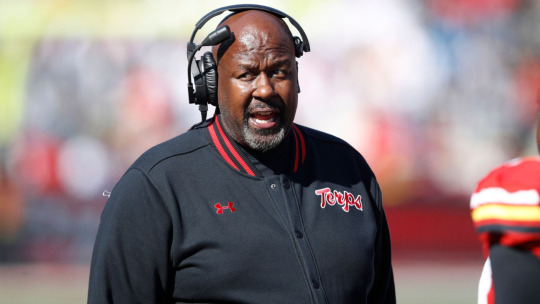
13. Mike Locksley
Record at Maryland: 6-17
Overall Record: 8-43
Movement: Same
Maryland showed some signs of life in 2020, especially with their road win over rival Penn State. If Locksley can translate that improvement into more wins he’ll start moving up the list.
-

12. Bret Bielema
Overall Record: 97-58
Movement: N/A
Welcome back to the Big Ten, Bret Bielema! Bielema was of course the coach at Wisconsin from 2006 to 2012 and he led the Badgers to three consecutive Rose Bowls. I have my doubts that he can replicate that kind of success at Illinois, but here’s to hoping.
-
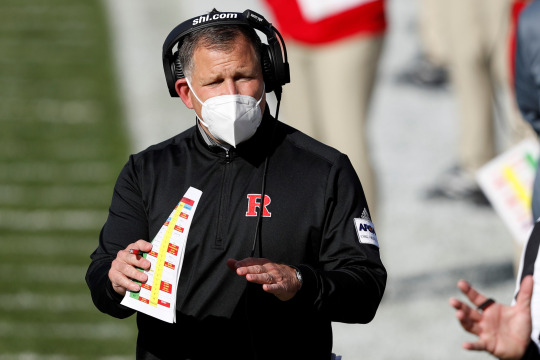
11. Greg Schiano
Record at Rutgers: 71-73
Movement: Down 1 spot
It took Greg Schiano 5 years to get to a winning record at Rutgers the first time he was a had coach there, so we need to give him some time to turn things around in Piscataway.
-

10. Tom Allen
Record at Indiana: 24-22
Movement: Up 1 spot
Indiana had a hell of a year under Tom Allen. The Hoosiers went 6-2, finishing 2nd place in the Big Ten West. It was their best season in decades and if a full 12 game schedule had been played there’s a decent chance that IU would have gotten to 10+ wins. I hope Allen can keep things running smoothly at Indiana, it’s always great to see long downtrodden programs rise up to compete with the big boys.
-

9. Scott Frost
Record at Nebraska: 12-20
Overall Record: 31-27
Movement: Same
Is Scott Frost the guy who can turn around Nebraska? I don’t know, he’s starting his 4th year and is still attempting to make his first bowl as Cornhusker head coach. I know the program has taken a nosedive and realistically will never be on Ohio State’s level anymore, but in the Big Ten West you should be able to find 6 wins in a season. Any day now.
-

8. Jeff Brohm
Record at Purdue: 17-21
Overall Record: 47-31
Movement: Same
I have half a mind to move Brohm and Frost even lower given their specific circumstances, but I’ll trust in them a bit longer since they both did so well at their previous stops. Brohm’s Purdue Boilermakers have been struggling in the past few years despite their initial success. I honestly have no idea if Brohm can right the ship a second time, I know fans are disappointed how things have played out considering the promising start of his tenure.
-

7. P. J. Fleck
Record at Minnesota: 26-19
Overall Record: 56-41
Division Titles: 1 (2019)
Movement: Down 1 spot
Minnesota regressed in Fleck’s fourth season at the helm. Given the 11 win season in 2019 I think Fleck has earned some patience. He’ll rise back up in the rankings as long as the Gophers continue to build up their program under his careful guidance.
-
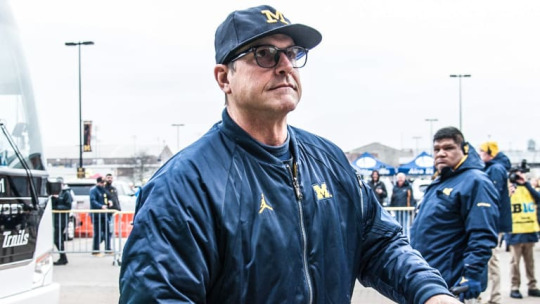
6. Jim Harbaugh
Record at Michigan: 49-22
Overall Record: 107-49
Division Championships: 1 (2018)
Movement: Down 1 spot
Jim Harbaugh tumbles out of the top 5 after Michigan suffered their first losing season under his leadership. I know the dramatic regression came as a surprise to Wolverine fans, many of whom are concerned with the direction things are heading with the program. It’s a tough position for the coach and the administration, who will struggle to beat Ohio State no matter who is coaching the team. We’ll see if Harbaugh can turn things around in Ann Arbor, he might not get too many chances if things don’t break his way in 2021.
-

5. Paul Chryst
Record at Wisconsin: 56-19
Overall Record: 37-13
Division Championships: 3 (2016, 2017, 2019)
Movement: Down 1 spot
Wisconsin was fine in 2020. I expect them to compete for division titles every year and they did, the Badgers just didn’t win this time. Better luck next year. Wisconsin hasn’t gone two years without at least tying for the West title so I am confident that they’ll be competing in 2021.
-

4. James Franklin
Record at Penn State: 60-28
Overall Record: 84-43
Division Championships: 1 (2016)
Conference Championships: 1 (2016)
Movement: Down 1 spot
Much like Michigan, Penn State suffered from a similarly horrible year. James Franklin has done much for the Nittany Lions, bringing their program back into regular competition with the top flight of college football. However, losing seasons don’t come out of the blue very often to a well run program. We’ll see if this downturn is just an aberration. Franklin certainly still seems like he’s capable of turning things back around.
-
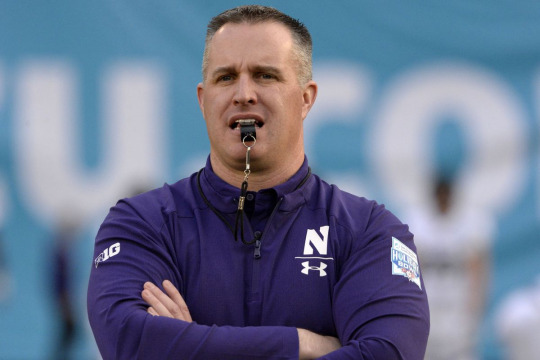
3. Pat Fitzgerald
Record at Northwestern: 106-81
Division Championships: 2 (2018, 2020)
Movement: Up 4 spots
Pat Fitzgerald really outdid himself in 2020. The completely unheralded Wildcats went out and beat both Iowa and Wisconsin to win the Big Ten West for the second time in three years. NU continues to punch above its weight and it’s all thanks to the hard work of Pat Fitzgerald and his staff. I don’t know if Northwestern can ever really be a year in and year out competitor in league play, but if anybody can do it Fitzgerald can.
-
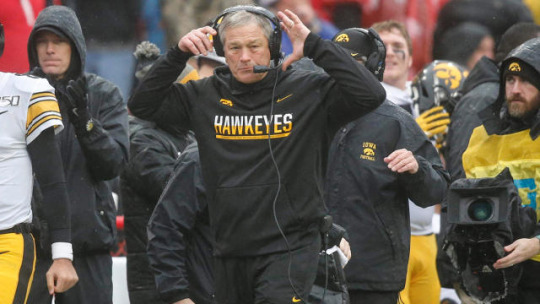
2. Kirk Ferentz
Record at Iowa: 168-106
Overall Record: 180-127
Division Championships: 1 (2015)
Conference Championships: 2 (2002, 2004)
Movement: Down 1 spot
The longest tenured coach in FBS football has slipped down one spot. It’s not really his fault, it’s hard to keep pace with a guy who’s making the Playoff every year. Ferentz is a living legend and as long as he’s around Iowa is going to be just fine. The Hawkeyes continue to battle it out with Wisconsin for West Division supremacy and I don’t think that will change for the time being.
-
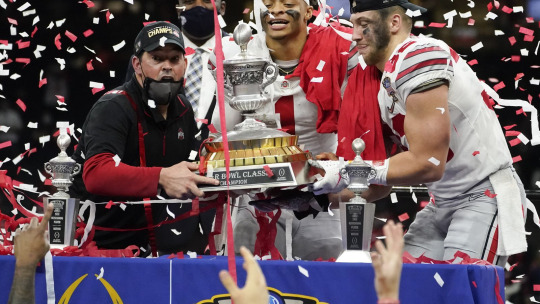
1. Ryan Day
Record at Ohio State: 23-2
Division Championships: 2 (2019, 2020)
Conference Championships: 2 (2019, 2020)
Movement: Up 1 spot
Ryan Day hasn’t crashed the Ferarri yet. Ohio State was the second best team in the country last year after an Alabama squad that might have been the greatest ever. That’s not bad competition. The Buckeyes seem well served by Day so far and will compete for Big Ten and national championships for the foreseeable future as long as he’s in Columbus.
#college football#Michigan State Spartans#Maryland Terrapins#Illinois Fighting Illini#Rutgers Scarlet Knights#Indiana Hoosiers#Nebraska Cornhuskers#Purdue Boilermakers#Minnesota Golden Gophers#Michigan Wolverines#Wisconsin Badgers#Penn State Nittany Lions#Northwestern Wildcats#Iowa Hawkeyes#Ohio State Buckeyes
1 note
·
View note
Text
hi everyone it’s me, local lemon demon & tally hall fan, posting about a band that you’ve never heard of and is only tangentially related to lemon demon & tally hall but still more related than i ever expected to be. the fullerenes, and their final ep, the temporary boyfriend ep. enjoy
-two disclaimers i have to get out of the way. the first is that this isn't my first time listening to this album, that was earlier today, and i'd even listened to a couple songs on their own before then. the second is that 90% of this is just going to be me gushing about how fantastic this album is because holy shit it's good like the mixing is amateur the lyrics are about cishet love but i don't care i love this goddam ep
-bassline. piano. dischordancy. what's not to goddam love
-the story of this song is some guy being in love with a with an androgynous name (& is not referred to with any gendered language!) whom he's never spoken to, only like bumped into once some time. i don't hate it because i know exactly how much worse it could be. that's my stance on all of the fullerenes' love songs honestly
-i bring up the androgynous name because i will hc adrian as enby to the death. i'll do this with any fictional character honestly
-alright back to the song. fast-paced as any fullerenes song will be, but the piano riffs/melody have barged into my heart where they pay rent & tip each week, more than making up for anything lackluster in the drumming/guitar aspects
-as if there would be any
-unfortunately i'm going to have to pause like. a lot. even more than i usually do with an album. because the songs are fast paced & go by quickly & i can't quite keep up with them
-that bass riff. i can tell there's some real musical knowledge behind it. and if you're going to put your musical knowledge anywhere the bass is like the 1st best place for a rock band & the 2nd best place for an ann arbor beginning of the 2000s quintet that dresses smartly with matching ties at live performances & is traditional rock with a keyboarder and other miscellaneous instrument useage/experience. what's tally hall
-ok to completely ignore the last thing i said this soft guitar arpeggio combined with the vaguely harmonious feedback was a 2-hit combo of tally hall flashbacks (i know it's just the same & two wuv, respectively) the first time i heard it and i don't know how long it'll take till that goes away
-good lord the lead singer isn't the most skilled person in the universe but these harmonies! they kick me in the head and save my soul i want to get lost in this rock & roll
-by far the most emo song on this album, broken down, and who doesn't need a little emo. by which i mean the lead vocalist screams sometimes there's not a whole lot more angst by comparison beyond that
-the hooks. this song's got a hook. and the keyboard. the keyboard. watch me fill up this whole liveblog with just mentions of the instruments & musical components
-practically the only thing pushing this song past the 2 minute mark is the guitar/keyboard solo & i sure as hell can't complain about that it slaps
-i won't lie this bit with the vocal filter is a very silly reminder (to me) of lemon demon's first 2 albums. i mean. i think this ep & those albums came out about a year apart. and neil was a fullerenes fan. so maybe my remembrance is based in something more
-temporary boyfriend the song itself. i literally haven't listened to their full discography but if i had to pick a song to introduce people to the fullerenes & it couldn't be little fits then it'd definitely be this one alright
-it's got the most typically pleasant vocals, keyboard accompaniment the whole way through, gentle & groovy guitar, very well done vocal harmonies, lyrics aren't alloromantic shit, it's the perfect intro to this band
-also, i can already tell it's going to be stuck in my head for goddam ages & i'm only listening to it for the 2nd time
-i wonder if this band's anywhere on spotify? or any other music platforms? i would bet money against it honestly i only found it through a hella deep rabbit hole, their yt channel is tiny, and they aren't selling the album for any money on bandcamp. if anyone's still into logan whitehurst & the jr science club today maybe they'll find their way towards it but otherwise you'd probably have to encounter it a. the same way i did or b. through me specifically
-because i've only had the fullerenes for half a day but if other people don't start hearing about them i'm going to make their life hell
-that meme doesn’t translate well directly onto text. especially when you don’t want to bring up su*cide. moving on
-yknow. if you've seen my deporitazposting then get ready for that part ii except now there's even even less people who care about this defunct 1998-2002 music group (put group in quotations for deporitaz's part)
-oh and onto the finale. this is the song i've heard once or twice before the album and like. it's fast paced angery breakup song but in a vague bubblegum rock style.
-sure the love song aspects aren't my favorite but i enjoy these hooks and the power chords are tight. can't hate it!
-catch me, an ace/aro, never intend to & never have been in a ~committed relationship, belting the lyrics to this one at the top of my lungs at 4pm on a monday
-shit i need to update my "no love song writers are allowed in the alloromanticism" meme with. whoever's the lead songwriter for this band. is it ryan? ryan something? i don't entirely know yet but in my defense the fullerenes have a practically nonexistent internet presence, let alone general multimedia (non-musical) presence
-i had also listened to the love me true demo before going through the whole album and i've gotta say it doesn't sound a load rougher than the average fullerenes song. which could either show that a. fullerenes songs aren't terribly studio finessed, b. this demo is really well done, c. i have low standards, or d. i don't know the fullerenes' style well enough to point out how this is unfinished
-the vocal harmonies are on full display in this track- far more than the other ones even, i think.
-i guess you could say it's on ~fullerenes display haha
-oh the album's over. yeah it's only an ep & the songs aren't too long. the other ones have a shit ton more tracks at least. good times!
#the fullerenes#it is wack tagging them let me tell you. a shit ton of this stuff's wack honestly especially for yall. it's wack for me too but i don't need#to talk about that round here i've got better places than these tags#loolin liveblogs#but genuinely this is the first time y'all are seeing me really really actually truly liveblog something new. in the past it's been#something i know really well or with commentary. and then it was things i know very well but in a different format which is something#and i guess here even i did listen to the album before liveblogging it. but still it's a totally new group to me & to y'all i'm sure#y'all get to see me fall in love with something brand new of my very own as it's going down. this is going to be fun#tis i#anyway blease listen to the fullerenes their albums are pay-what-you-want on bandcamp & nobody else even knows about them i beg you /lh#to the world and back again
3 notes
·
View notes